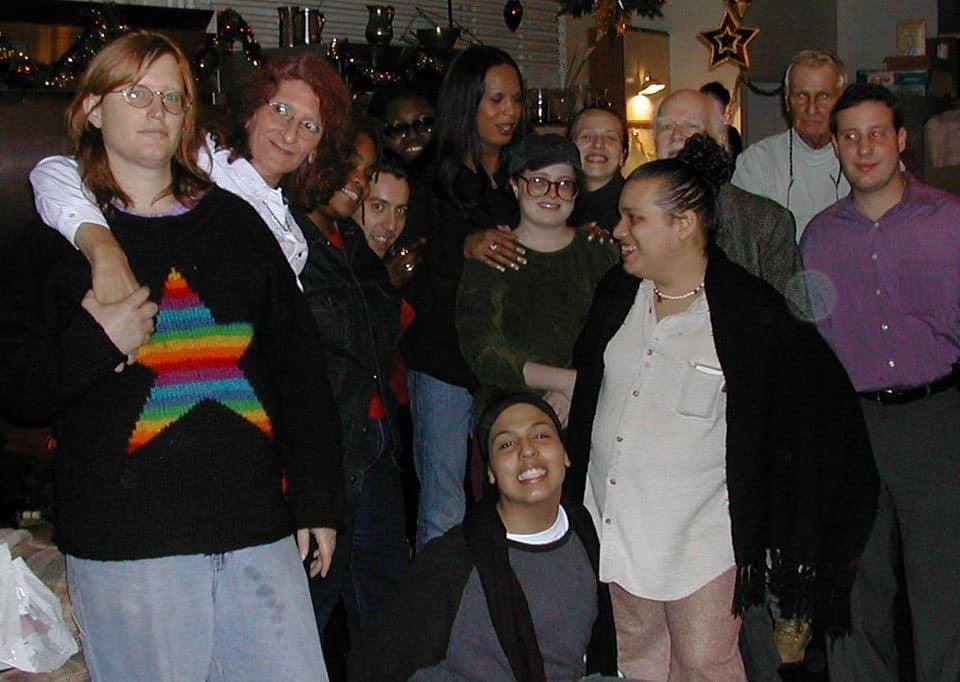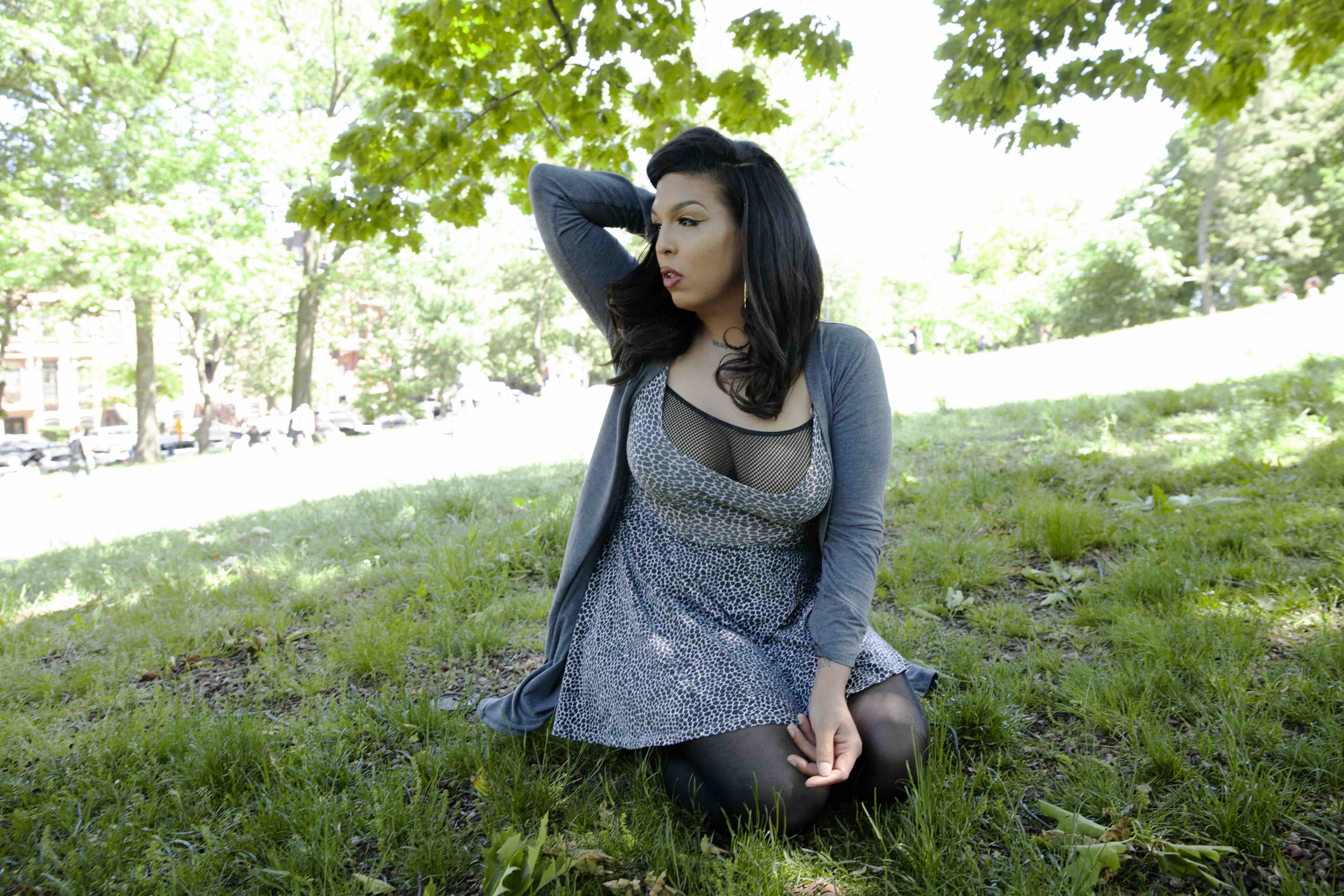Queers Built This is our project about queer inventiveness and DIY culture then, now, and tomorrow.
For about half her life, Mariah Lopez—a whip-smart trans Black-Latinx woman from New York City—cycled between group homes and juvie, fighting boys and selling sex for survival. In 2001, a familiar choice arose: “get locked” again, or run away.
But life—or, rather, her social worker—gave Mariah something else when she was still a teenager: a Metrocard and an address on a sticky note. Sylvia Rivera is waiting for you, Mariah recalled her social worker saying.
When she arrived, Mariah was welcomed into a rickety Brooklyn brownstone by two middle-aged white trans women—one named Rusty; the other, Chelsea. The three were chatting in the parlor when Sylvia, the 50-year-old trans Latina revolutionary hailed as a founder of the modern transgender political movement, walked in, sporting a cut-off T-shirt and a headscarf. The adults mulled over what to do with the teenage girl in front of them.
Mariah interjected, “Fuck them!”—the white ladies. She wanted the opinion of the woman she had come to see. “Sylvia—”
“Oh no, honey,” Sylvia interrupted. “You don’t call me Sylvia no more. I’m your mother. You call me Ma.” For the next few years, Mariah, now a friend and activist-colleague of mine, lived at the house, run by and for trans people—finding stability and trans elders, two things she’d never really had.
***
Almost 30 years earlier, 19-year-old Sylvia and other Street Transvestite Action Revolutionaries (STAR) activists, including movement mother Marsha P. Johnson, transformed a Mob-owned apartment in New York’s East Village into a sanctuary for trans girls like the yet-to-be born Mariah—young people who were often unstably housed and sex-working.
Just before they opened STAR House in November 1970, as historian Martin Duberman documented in the book Stonewall, Sylvia and “some two dozen young street transvestites” had lived in the back of a trailer truck in a Greenwich Village lot. That didn't last long: One day, Marsha and Sylvia returned to the lot only to see their makeshift home driving away.
In search of a new home base, STAR co-founder Bubbles Rose Marie struck a deal with Mike Umbers, a gayborhood business owner and alleged mafioso: a four-roomer in what Village Voice writer Arthur Bell described as a “dilapidated hellhole of a building” in exchange for cheap rent. There, Marsha and Sylvia lived with Bambi L’Amour––a Black street queen befriended by Sylvia during a stint on Rikers Island–– Andorra Marks, another Black queen, and a revolving group of others. They made the place home, reviving the defunct boiler with a bit of elbow grease, decorating the walls with posters demanding political prisoners’ liberation, and filling the home with puppies that roamed floors dotted with empty Hawaiian Punch cans, as Bell saw when he visited in July 1971.
Despite their youth, Sylvia and 25-year-old Marsha were the mothers of STAR House, working johns to put food on the table and keep the roof over their head. “We didn’t want the kids out in the streets hustling,” Sylvia told writer Leslie Feinberg in 1998. To stock the cupboards, they turned tricks and performed what Sylvia called “Fingers for Jesus”—aka, shoplifting—as Sylvia's late friend, Reverend Pat Bumgardner, an LGBTQ minister and activist, told me in May 2020.
STAR House was soon undone by the very economic precarity from which STAR girls sought respite. On July 15, 1971, Umbers evicted them for failing to make rent. "I think I'm doing more for the gay cause than any of your organizations,” Umbers told the Village Voice, “but I'll be fucked if I house that bunch rent-free.”
The girls were forcibly displaced—but remained hopeful. “It's one chance in a million we'll find another building,” Sylvia said in the same article. “Maybe the next time we'll succeed. People will back us up.”
Two years later, neither had happened. Sylvia had found a new building for STAR House just 10 blocks north of the previous one, but it seems to have had a short life, and other details about it are unknown. During a fiery 1973 speech denouncing the exclusion of incarcerated and unhoused “street queens” from gay liberation, Sylvia challenged the booing, largely cis—and, likely, mostly white—gay and lesbian audience to educate themselves about such oppression by visiting the renewed housing collective. Written histories suggest this to have been STAR House's final iteration.
“Her idea was really wonderful,” said Jennie Blickney, a social worker who met Sylvia and Marsha in the early 1980s, when Blickney was a child. She knew Sylvia until her death in 2002. “But it never came to fruition.”
***
In the summer of 1994, Rusty Mae Moore, a Hofstra University professor of international business, moved from Long Island with her pagan girlfriend, Chelsea Goodwin, to Brooklyn to be closer to her kids from a previous marriage—not to start an informal shelter for unhoused trans women, as Sylvia and Marsha had done for street queens 20 years prior.
Still, that’s exactly what happened. At first, the people living in the house were just the couple—both of whom are white and trans—and their friend Julia Murray, another white trans woman who would eventually fall in love with and be partnered with Sylvia in her final years. But “people started to come out of the woodwork,” Rusty told the New York City Trans Oral History Project in 2017. By 1995, word got out within certain queer and trans circles about a house owned by trans women—a rarity. Some social workers began referring young trans girls to them simply because the city lacked better options.
“I’d be working in my office, the doorbell would ring, I’d come downstairs, there’d be some homeless trans person there standing there [sic], and I’d be like, Oh yes, may I help you?” recounted Chelsea.
The potential resident would explain who sent them, and, according to Chelsea, she would say something like, “[A]lright, come in, and we’ll see what we can do to get you sorted out.”
“We didn’t have any mission about it,” said Rusty. “But then, when people started to come, we sort of took it as a mission to help younger people.”
STAR House’s legacy and influence shaped the three-story row house in Brooklyn into the now-historic Transy House. Chelsea introduced Sylvia Rivera’s housing activism to her partner, and “[w]e sort of began to see ourselves in that model,” said Rusty. But the connection wasn’t just ideological: Transy House was Sylvia’s home for the final years of her life. She moved in around 1997 after living, unhoused, on the Christopher Street Piers earlier in the decade.

The stability Transy House provided to residents of color made their continued historic activism possible. Sylvia was able to dive into the growing fight for trans rights legislation—while also briefly resurrecting STAR—because she had a reliable place to rest her head, the homeowners and Blickney believe. Sylvia seemed to believe that Transy House was following in—and even surpassing—the footsteps of STAR House.
"You people are doing what I always dreamed of doing," Sylvia said of the housing collective run by and for trans people, according to Rusty’s account in the 2009 documentary Changing House. It wasn’t a non-profit or a formalized social service organization; it was just trans women helping other trans women with what they had available to them.
Mariah Lopez also found her footing at Transy House. Her home nourished what she described as the “audacious” fighting spirit she needed for waging a nearly-decade long slew of legal battles that demanded—and eventually helped win—the payment of sexual reassignment surgery by the city’s Administration of Child Services for its clients, including Mariah. Her stay at Transy House, as well as her time living with Sylvia, also inspired her reboot her mother’s STAR as Strategic Transgender Alliances for Radical Reform in 2014.
Despite proving invaluable to its residents, Transy House eventually closed in 2008—but not because of a shady landlord, like the one who folded STAR House. Instead, the founders closed it on their own terms. Rusty wasn’t “convinced” that an informal residence was best for the girls grappling with problems including trauma and poverty.
Chelsea agreed: “Having a nice middle-class college professor and her hippy girlfriend trying to deal with these tremendous social problems in one little brownstone—you might as well try to sweep the tide back with a broom.”
***
In the small hours of a February morning in 2002, Rev. Bumgardner rushed to St. Vincent’s Hospital to see Sylvia, who was by then the food pantry director at the Reverend’s Metropolitan Community Church (MCC).
On her deathbed, Sylvia was not making much sense. She grabbed Bumgardner’s arm, digging in her nail. In a moment of lucidity, Bumgardner said, Sylvia asked, "Are you going to do this, or not?" Her question was a request for something the two had frequently discussed: to open an LGBTQ emergency youth shelter in MCC’s basement.
Bumgardner promised, and she kept it, giving birth to Sylvia’s Place, which is still kicking.
“It’s the most on-the-books way to actually do the model that Sylvia believed in,” Mariah said, referencing STAR’s aim to provide a safe respite for any unhoused trans person, no questions asked. Sylvia’s Place makes good on this, Mariah believes, by “providing anyone who walks in with a cot, zero barriers,” adding, “They don’t get enough credit.”

But the city’s unhoused trans women still don’t have a shelter run by and for them—and Mariah is working to change that. While homeless in 2017, Mariah was turned away from Marsha’s Place, the only city-operated LGBTQ youth shelter, because she had a medically prescribed service dog. Without an attorney, she sued the city for disability discrimination, and is now in settlement negotiations with the representation of the Center for Constitutional Rights. At stake is the opportunity to overhaul the system that failed herself and her mother, Sylvia.
A patchwork of grassroots local efforts—such as the volunteer-run Trans Housing Atlanta Program or San Francisco’s coalition campaign Our Trans Home SF—and digital aid efforts—like Facebook groups for finding housing or crowdsourced fundraising to make rent—aim to reduce trans people’s housing instability. But it would be a huge victory for trans people across the country if politicians and policies systematically addressed the homelessness experienced by over half of surveyed Black, Indigenous, and multiracial trans women in their lifetimes.
Trans-specific system-wide changes are scant, and those in place are not effective: Pervasive discrimination persists, despite being banned by the Fair Housing Act in 2010. In theory, the gap in trans-inclusive and -led housing would be closed by progressive proposals to make housing a right, like Representative Ilhan Omar’s Homes For All Act and the #NYHomesGuarantee by New York state’s Housing Justice for All coalition. But neither of these initiatives address how they will serve marginalized groups, like trans women, who have been denied housing even in the face of legal protections. All the while, trans people’s access to shelters is actively under attack: the Trump administration proposed in 2019 to green-light trans discrimination in federally-funded shelters.
The fight to create sanctuaries for the most marginalized trans women was not invented by Sylvia, and will not be put to rest by Mariah. Instead, three generations—from Sylvia and Marsha, to Rusty and Chelsea, to Mariah—offer a map for how trans women can find, and make, home on their own terms, regardless of cisgender society’s involvement.
Follow Sessi Kuwabara Blanchard on Twitter.
from VICE https://ift.tt/2Ycykw1
via cheap web hosting

No comments:
Post a Comment